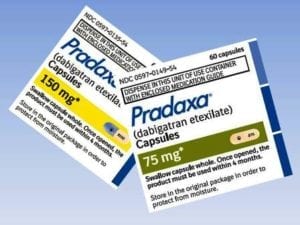The Basic Problem With Pradaxa (Dabigatran Etexilate)
In 2010, the U.S. Food & Drug Administration approved Pradaxa (Dabigatran Etexilate). Pradaxa acts as a blood “thinner” and is promoted to reduce the risk of stroke and blood clots in people with atrial fibrillation.
Atrial fibrillation, affecting over two million Americans, occurs when the heart does not beat properly causing blood clots to form and increasing risk of a stroke.
 Other medications like Warfarin (Coumadin) have been on the market a long time and have been used for the same conditions that Pradaxa is now marketed. Warfarin and Pradaxa work differently, however, to accomplish similar, but not identical goals.
Other medications like Warfarin (Coumadin) have been on the market a long time and have been used for the same conditions that Pradaxa is now marketed. Warfarin and Pradaxa work differently, however, to accomplish similar, but not identical goals.
Warfarin helps to prevent over clotting in the blood by inhibiting the development of Vitamin K clotting factors in the blood. Vitamin K is the central ingredient used by the body to develop clotting. In some people, particularly as we age, the body produces too much clotting ability and this can result in strokes.
Pradaxa works differently. Pradaxa inhibits the development of thrombins in the blood. The formation of thrombin in the body is a key step to coagulation and the stemming of blood loss. It is thought that Pradaxa’s inhibition of natural thrombin formation helps in controlling “over clotting” and stroke.
The difference in the way Warfarin (Coumadin) and Pradaxa (dabigatran) act upon the body is significant.
If a patient taking Warfarin is, for example, in an automobile accident and requires emergent surgery, physicians can reverse the action of Warfarin by giving Vitamin K and/or packed red blood cells.
The same patient on Pradaxa in an auto accident can not have the effects of Pradaxa (dabigatran) reversed as easily or as controllable. Pradaxa has a half-life of 12 – 14 hours and, so simply discontinuing it still places a patient in need of emergency surgery at high risk of uncontrollable bleeding.
Pradaxa has also been reported to cause internal bleeding without the emergent surgery problem. The bleeding can be serious, and sometimes leads to death. Boehringer Ingelheim, the manufacture of Pradaxa has acknowledged a link between Pradaxa and at least 260 deaths since 2010.
Because of this risk, people taking Pradaxa should be aware of the signs and symptoms of the problems caused by Pradaxa which should be reported immediately to your doctor. They include the following:
- Lethargy;
- bleeding gums;
- bleeding from cuts that takes a long time to stop;
- blood in the urine (brownish urine);
- blood in the stool (tarry appearing or dark stool);
- coughing up blood;
- low blood pressure;
- frequent or difficult to control nosebleeds;
- unusual bruising;
- vomiting blood; or
- vaginal bleeding that is heavier than normal;
You may have a higher risk of these adverse effects if you:
- are over 75 years old;
- have kidney problems;
- have stomach or intestine bleeding that is recent or keeps coming back;
- have certain kidney problems and take the medicines dronedarone (Multaq) or ketoconazole tablets (Nizoral);
- have a stomach ulcer; or
- take other medicines that increase your risk of bleeding, including:
- aspirin or aspirin containing products
- long-term (chronic) use of non-steroidal anti-inflammatory drugs (NSAIDs)
- warfarin sodium (Coumadin, Jantoven)
- a medicine that contains heparin
- clopidogrel (Plavix)
- prasugrel (Effient).
You should speak to your doctor before you have anysurgery, medical procedure or dental procedure. Furthermore, make sure to immediately notify your doctor if you develop any side effects while taking Pradaxa (dabigatran).
Share This


